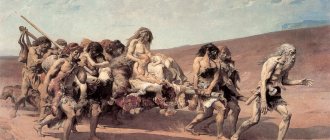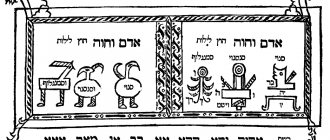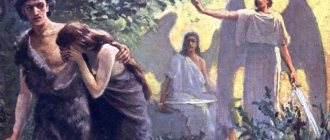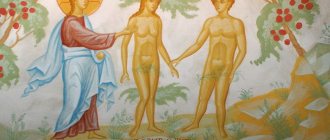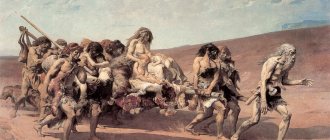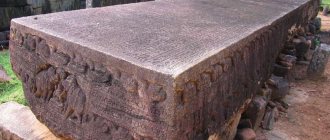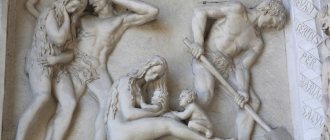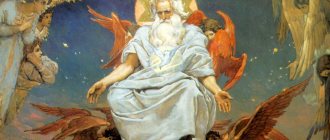| The creation of Adam and Eve. Expulsion from Paradise |
Adam and Eve
, the first people, the ancestors of the human race. Memory on the Sunday of the Holy Forefathers and on the Sunday of the Holy Fathers [1].
The word "Adam" is from the Hebrew adam letters. - red
, associated with adamah - earth, originally, apparently, red soil.
In the Bible, the word “Adam” is used in different senses: “man” (Gen. 5:2), “man” (Eccl. 7:28), “everyone” (Num. 19:14), “everyone” (Zech. 13:5), “people” (Judges 16:7), “first man” (Job 15:7), and also as a proper name. It is included in the expression “sons of Adam
,” which never means the immediate descendants of the first man. They can be called “people” (in the synodal translation “sons of men”) (Prov. 8:31; Ps. 44:3). Used in the singular (lit. “son of Adam”), it denotes a specific person (Ezek. 2:1) or anyone (Jer. 49:18).
Creation of the first people
Adam was created "from the dust of the ground"
(Gen. 2:7), therefore he is “earthly” (1 Cor. 15:47).
God “breathed into his nostrils the breath of life, and man became a living soul”
(Gen. 2:7). Adam was created as a spiritual-physical being, who is the bearer of the image of God Himself (Gen. 1:27). According to the Divine creative plan, he must also be like God (Gen. 1:26). This similarity, unlike the image, is not given, but is assigned to a person and must be realized by him throughout his entire life.
About the creation of the wife of the book. Genesis narrates twice, briefly: “And God created man... male and female he created them” (Gen. 1:27), and in more detail: “... for man there was not found a helper like him. And the Lord God caused the man to fall into a deep sleep; and when he fell asleep, he took one of his ribs and covered that place with flesh. And the Lord God created a wife from a rib taken from a man, and brought her to the man. And the man said, Behold, this is bone of my bones, and flesh of my flesh; she will be called woman, for she was taken from man.”
(Genesis 2:20-23).
| Creation of Eve. Modern icon |
The creation of a wife not independently of her husband, but from his nature (ancient Hebrew sela is not only a “rib” (as in the Synodal translation), but also a “side”, “side” and in general a part of something) emphasizes the duality of man. The Genesis writer himself draws attention to it, deriving the word “wife” (Heb. issah) from the word “husband” (is) (Gen. 2:23). The appearance of a wife is due to the fact that a person had a need for communication. As a bearer of the image of God, he could not remain alone: “it is not good for man to be alone”
(Gen. 2:18); The divine image had to be reflected both in the unity of human nature and in the plurality of hypostases. The creation of a wife is one of the main prerequisites for a person’s life in love, which is an indispensable condition for his “abiding” in God, for “God is love, and he who abides in love abides in God, and God in him” (1 John 4, 16).
The first man is the crown of the world created by God and, as such, has royal dignity, as evidenced by the fact that in the creative act God Himself graciously inhabits man and makes him the ruler of the world (Gen. 1:28). In accordance with his high purpose, man gives names to animals (Gen. 2: 19-20); he is called to “cultivate... and preserve”
the world around us (Gen. 2:15).
However, Adam's perfection was not absolute. It only served as the basis for the fulfillment of his calling and opened up for him the opportunity to become perfect, “as the Heavenly Father is perfect”
(Matthew 5:48).
Accordingly, man’s free will was not perfect, since it could choose not only good, but also evil, as evidenced by the commandment given to man, forbidding him to eat the fruits of the Tree of the Knowledge of Good and Evil (Gen. 2:17). Since only God gives the world He created “life and breath and all things” (Acts 17:25) and only through Him “we... live and move and have our being”
(Acts 17:28), the first man could achieve godlikeness only in unity with By God. Otherwise, he doomed himself to an autonomous, extra-divine existence, which inevitably led to death (Gen. 2:17).
Examples of the Fall in history
- Sodom and Gomorrah
There are several versions of why the Lord destroyed these cities: sodomy, greed, inhospitality. However, the main version is still homosexuality.
- Lot and daughters
The story of Lot and the fall of his daughters is described in Genesis. The daughters believed that after the terrible disaster sent by the Lord to their city, there were no men left. Both, having drunk their father, got together with him and gave birth to sons. They became the ancestors of the Moabites and Ammonites, from whom the Arab peoples descended.
- Fall of David
David ignored God's command not to take another man's wife. The presence of a large harem did not save the king from sin. Bathsheba became pregnant. David tried to make amends for his wrongdoing, but it led to a tragic end: the murder of Uriah (Bathsheba's husband). God sends the prophet Nathan to expose the king's crimes. David admits his sins only after a year. This story ended with repentance and reform, which does not happen often in the Old Testament.
The First Fall and its Consequences
| Adam and Eve. Painting in the catacombs of Saints Peter and Marcellinus in Rome. 2nd half III - 1st half. IV century |
It is not known how long Adam and Eve were in a blissful state of purity and innocence; all that is known is that they lost it. Our first parents could not withstand the temptation they were subjected to from the devil, and committed the first sin, wanting to become like gods without God (Gen. 3:1-6). Adam violated the commandment of God, carried away by his wife, who, seduced by the serpent, ate from the fruit of the tree of the knowledge of good and evil, Adam also ate from it, and by this sin they incurred the wrath of their Creator. The first sign of sin was a feeling of shame, and then a futile attempt to hide from the face of the omnipresent and omniscient God walking around evening time in paradise. Called by God, they expressed their fear and laid down their guilt: Adam - on the wife, and the wife - on the serpent. A terrible punishment befell all those involved in this fall, and in the person of the fallen ancestors the entire human race; however, it was dissolved by the first promise (first gospel) about the Savior of the world, who will be born of a woman: the seed of the woman will erase the head of the serpent
(Gen. 3:15), said the Lord.
As a result of the Fall, their nature underwent significant changes, although they were not of an ontological nature. Sin began to parasitize her, simultaneously preventing the action of Divine grace on her. The first people faced suffering, disease and death. The consequences of their sin affected all of humanity, which inherited from them human nature corrupted by sin, and on the surrounding world, in which, as the biblical narrative says, “thorns and thistles” began to grow (Genesis 3:18).
The first sons of Adam and Eve were Cain and Abel. Cain, out of envy, kills Abel, for which he was expelled and settled separately with his wife and had offspring (Genesis 4).
Little is known about the further life of the first parents: “Adam lived one hundred and thirty [230] years and begat [a son] in his own likeness [and] in his image, and called his name: Seth. The days of Adam after he begat Seth were eight hundred [700] years, and he begat sons and daughters. All the days of Adam’s life were nine hundred and thirty years; and he died" (Genesis 5:3-5).
According to Jewish legend, Adam rests in Judea, next to the patriarchs; according to Christian legend, on Golgotha.
How did the first people sin?
The sin of the first people in Paradise led to a distortion of man's relationship with God. Adam and Eve, seduced and succumbing to temptation, began to perceive the forbidden fruit (not necessarily an apple) only as a “thing for themselves”, and not an object of God’s commandment. That is, Eve, succumbing to the devil’s temptation, began to see in the forbidden fruits not what they really are, but what she herself desired:
- It is good for food, has a wonderful taste, since it is prohibited! This is the lust of the flesh;
- How beautiful he is, pleasing to the eye. This is the lust of sight, the desire for pleasure;
- Giving new knowledge, the same as that of God (according to her understanding). This is the pride of life.
It must be well understood that Adam and Eve did not sin in Eden in a carnal way. God Himself commanded them to be fruitful and multiply, and in no way hindered physical intimacy. The essence of original sin was that they violated the commandment, the agreement with the Creator, in their proud desire to become equal to God.
This is precisely the thought that the enemy instilled in Eve: you will be like gods, you will know everything yourself! Thus, the greatest sin of pride, which had previously seduced Dennitsa to rebellion against God, turning him into Satan, a hater of all people, was transferred to the Ancestors and accepted by them.
The universal significance of the nature of the first man
The first people, Adam and Eve, are the ancestors of all humanity. There was no other root from which the human race took its beginning, either before or after them. In Gen. 2:5 it is said that before the creation of Adam there was no man to cultivate the land, but in Gen. 3:20 the name of the wife is reported and it is explained that she was called Eve (Hebrew hawwah - life), because she became the mother of all living, that is, the foremother. The unity of the human race is evidenced by the Old Testament genealogies leading from Adam (Gen. 5, 1; 1 Chron 1), and in the New Testament in the genealogy of Jesus Christ, the Evangelist Luke indicates that Christ is not only the Son of God, but also the Son (i.e., a descendant ) Adam (Luke 3:23-38). Finally, Acts tells us that the entire human race was created “of one blood” (Acts 17:26).
The Apostle Paul calls Adam not only “the first man” (1 Cor. 15:47), but also “the image of the future” (Rom. 5:14), meaning the Son of Man, who came to “renew” fallen Adam, “the first” and “early” man (1 Cor. 15:47). The “Second” Man is Jesus Christ; at the same time He is also the “last Adam” (1 Cor. 15, 47, 45). The Apostle, contrasting the first and second Adam, points out that from the “earthly” man a Christian inherits a nature corrupted by sin, the destiny of which is inevitable death, and from the “heavenly” Man (1 Cor. 15:48) - a regenerated nature, the destiny of which is eternal life. “Like the earthy, so are the earthy; and as is the heavenly, so are the heavenly. And just as we have borne the image of earth, we will also bear the image of heaven” (1 Cor. 15:48-49). Thus, being a son of Adam by birth and reborn in Christ, the Christian is in constant connection with the first and second Adam. He is called, according to the words of the same apostle, “to put off his former way of life, the old man, which is corrupted by the deceitful lusts... and to put on the new man, created according to God, in true righteousness and holiness” (Eph. 4:22,24).
About two Adams after the apostle. Paul teaches St. Irenaeus of Lyons, noting that “in the first Adam we offended [God] by not fulfilling His commandments” and “reconciled [with Him] in the Second Adam, “being obedient even to death” [2]. In the Redemption, according to the same St. father, Christ “headed (recapitulavit) all mankind, giving us salvation, so that what we lost in Adam ... we received again in Christ Jesus” [3].
The idea of the universal human nature of the first man was reflected in the patristic and liturgical tradition of the Orthodox Church. Churches. St. Gregory of Nyssa believes that “this name “Adam”... is given to created man not as any one, but as a general race.”
[4].
Trying to understand the pan-human character of Adam’s nature, some Christian thinkers (for example, Vl. S. Solovyov, Archpriest S. Bulgakov) deviated into speculative constructions, as a result of which the first man became more than one (more precisely, the first) hypostasis with a universal human nature , but a multi-hypostatic personality, in which each person, in some incredible way, was already present in his own hypostasis. The anthropological fallacy of such ideas inevitably led to an error in the field of soteriology, to a distortion of the doctrine of original sin and the salvation accomplished by the Second Adam - Jesus Christ.
Consequences
This sin is revealed as original because it became the root of all other sins. Without it, neither adultery, nor theft, nor murder, nor other violations of the commandments would have appeared.
It became the basis and cause of damage to the entire nature of man, his soul and body. And all the seed of Adam, his descendants and the foremother Eve carry within them the sprouts of original sin: bad will, weakness under the influence of demons, readiness to carry out their unclean instructions.
The only one of all who escaped the manifestation of original sin in himself was the God-man Jesus Christ, Who was conceived by the Holy Spirit, combined in Himself two principles, Divine and human, and therefore did not carry within Himself the seed of this sin.
The Catholic Church claims that the Virgin Mary did not inherit this damage to nature, like the Infant God, and was thereby freed from original sin. This is the so-called Dogma of the Immaculate Conception of the Virgin Mary, according to which the Mother of God does not carry it within Her, despite the fact that she was conceived by Her parents naturally.
The Fall of the First People in Paradise
This dogma was proclaimed in 1854, and states that this non-involvement was granted to Her from birth, on account of the future merits of Christ the Redeemer. While in Orthodoxy we deeply reverence Her personal sinlessness, at the same time accepting the understanding that She is not deprived of the action of original sin.
Thus, all people, all descendants of the Ancestors, conceived in the usual way, without the participation of Divine powers, bear the mark of original sin, and must make considerable efforts to resist hostile spirits that in every possible way attract to evil, prompting the sinful nature to commit direct sinful action.
Traditions about Adam and Eve among different nations
The story of Adam and Eve, with greater or lesser modifications, is preserved in the traditions of almost all ancient peoples, especially the Semitic generation.
The legends of the Zend Avesta among the Persians are similar to the biblical legends about the first man. Ormuzd created the first man from fire, water, air, earth and breathed into him an immortal soul. In the Garden of Eden grows the tree of life - Hôm, the fruits of which give immortality. The vengeful Ahriman in the form of a serpent appears to the ancestors, seduces them and disrupts the happiness of the immortal soul. According to Persian legends, vultures guard the golden mountain.
According to Brockhaus, both Jews and Persians borrowed their legends about the first people from ancient Assyro-Babylonian sources, since identical legends are also found in wedge-shaped inscriptions compiled 2000 years BC, i.e. long before Moses and Zoroaster, and discovered in modern times in the ruins of ancient Nineveh. On one tile from a collection of tiles recovered from the ruins of the Sardanapalus Palace, stored in the British Museum, there is the following fragmentary inscription: “After the gods created living beings, cattle and beasts and creeping things of the field... god (Hao) created two...”.
Here, obviously, we are talking about the creation of the first man, and the Assyrian tradition is thus consistent with Gen. 1, 26-30. We find a similar coincidence between the biblical and ancient Babylonian tradition regarding the legend of the Fall, which in Assyrian sources is even illustrated by bas-relief images. Thus, one bas-relief on a cylinder, also kept in the British Museum, depicts a man and a woman sitting near a tree and stretching out their hands to its fruits. A snake rises from behind the woman. Another bas-relief also represents a tree covered with fruits, surrounded by winged figures. Obviously, the first bas-relief depicts the fact of eating the forbidden fruit, and the second depicts expulsion from paradise and its guarding by cherubim.
Later teachings inherited the ideas about the creation of the world among Jews and Christians, with varying degrees of “creative processing.” Thus, the Koran says that God created the body from clay and the soul from fire. All the angels recognized the new creation, but Eblis alone refused and was expelled from paradise, where Adam settled. Eve was created in paradise. Eblis, out of revenge, seduced the first people, and they were thrown to the ground. God took pity on the repentant Adam and sent the Archangel Gabriel to teach him the commandments of God on the very spot where the temple in Mecca was later built. Adam religiously fulfilled the commandments, for which 2000 years later he found his wife again on Mount Ararat. Adam is buried on Mount Abukai, near Mecca.
Heredity
First of all, it manifested itself in the fact that Adam and Eve, created by God in His image and likeness, not previously distorted by original sin, after the Fall began to pass on this damage to their descendants. Adam gave birth to them no longer in God’s image and likeness, but in his own, distorted by the Fall.
And all of humanity was born affected by this disease, no matter how sinless they were in themselves! You can often hear from people of little faith: “Adam sinned: what do I have to do with it?” It was said by the righteous Job: “Who will be clean from filth? No one else, even if he lived only one day on earth” (Job 14:4-5). That is, even a baby who has just been born and has not had time to sin in any way already bears the mark of original sin!
Therefore, the Orthodox Church considers it advisable to baptize newly born babies, without waiting for them to reach the age of reason, as some adherents of heretical teachings do. The heredity of original sin is a given that cannot be avoided, but can be corrected by accepting Holy Baptism and becoming a church member.
Iconography
| Descent into hell. Dionysius. 1502-1503 |
The images of Adam and Eve are based on the texts of the book of Genesis (Gen. 2, 7-25; Gen. 3, 1-24; Gen. 4, 1-2).
The earliest and most common plot in the monuments of Christ. art - the fall of Adam and Eve, for example: paintings of the catacombs of San Gennaro in Naples, 3rd century, and Saints Peter and Marcellinus in Rome, 2nd half. III - 1st half. IV century; painting of the Dura-Europos synagogue (Syria), ca. 250 g; painting of the tomb of Aurelius in Rome, 3rd century; sarcophagus of Junius Bassus, 359 (Vatican Museums). Naked Adam and Eve are depicted standing at the Tree of the Knowledge of Good and Evil, around which a serpent is entwined. On the sarcophagus of Junius Bassus there is a sheaf of ears of grain next to Adam, and a sheep near Eve, which indicates their labors after expulsion from paradise. Scenes from the story of Adam and Eve are illustrated in detail in miniatures from early manuscripts.
The patristic tradition of comparing Christ with Adam and the legend that Golgotha, where the Savior was crucified, is the burial place of Adam, determined the image of Adam or the head of Adam in the composition “The Crucifixion”. The idea that the blood of the Savior atoned for the sin of Adam is expressed directly in iconography - drops of blood from the wounds of Christ fall on the head of Adam. The image of the head of Adam in the cave under Golgotha has been known since c. [5]. In Byzantine art there are compositions where in the lower part, on the sides of Golgotha, Adam and Eve are depicted rising from the tombs [6]. This detail can be explained by the influence of the iconography of the “Descent into Hell,” known since the 9th century. [7]. Adam appears as a gray-haired old man, in a tunic and himation, Eve - in a red dress and maforia.
Adam and Eve kneeling on either side of the Etymasia (prepared throne) are depicted in the composition “The Last Judgment” [8]. In the image of an elder, Adam is depicted among the Old Testament forefathers and prophets in temple paintings [9].
In Western iconography, the “Crucifixion” type with the half-figure of Adam at the base of the cross has become widespread [10].
Vice: what is it from the point of view of Orthodoxy
What is meant in Orthodoxy by the concept of “Sin”? This is a thought, desire, or action (in some cases, inaction) that conflicts with God’s commandments, moral laws, and religious norms.
According to St. John of Damascus, “Sin is a voluntary deviation from that which is in accordance with nature into that which is unnatural (against nature).”
It is interesting to note that this word comes from the Greek “miss”, “shot wide of the target”. Thus, the sinner misses the purpose of human existence, falls short of his destiny to conform to the image and likeness of God.
Sin, settling in the human soul, gives rise to illusions in it:
- Freedom,
- Knowledge,
- Pleasure.
By flouting generally accepted rules, the sinner imagines himself free from restrictions (religious, social, family rules), but he falls into a much greater, slavish dependence on his sinful lusts and actions. Hiding behind the acquisition of new knowledge, the sinner simply justifies his true goals: to develop pride, to satisfy lust, to gain new pleasures.
He cannot understand that satisfaction from sin each time gives rise to new, even greater lusts, which again require new pleasures. This is akin to the desire of a drug addict who increases the dose each time to achieve new pleasures.
The Creation of Adam and Eve, the Fall, Expulsion from Paradise. Middle composition of the northern altar door of the Annunciation Cathedral in Solvychegodsk.
And until there is complete awareness of one’s sin, repentance for it, an all-consuming desire to cleanse oneself, to reconcile with the Divine will, there will be no return to God.
And then action is necessary: the sinner must resolutely give up sinful habits: the fornicator must lead a chaste life, the drunkard must give up wine, the glutton must eat in moderation, the lover of anger must acquire humility, and so on.
The sacrament of church repentance, communion of the Holy Mysteries of Christ, and churching are necessary. Only along such a narrow, thorny path can one find the path to God again.
Literature
- Malov E., prot. About Adam according to the teachings of the Bible and the teachings of the Koran. Kaz., 1885
- Filaret (Drozdov), archimandrite. [Metropolitan Moscow]. Notes on the book of Genesis. [1816]
- Bogorodsky Ya. A. The beginning of the history of the world and man according to the first pages of the Bible. Kaz., 1902
- Thielicke H. How the World Began: Man in the First Chapters of the Bible. Phil., 1961
- Renckens H. Israel's Concept of the Beginning: The Theology of Genesis 1-3. NY, 1964
- Seraphim (Rose), Hierom. Orthodox understanding of the book of Genesis: Trans. from English M., 1998
- Flemming J. Die Ikonographie von Adam und Eva in der Kunst vom 3. bis zum 13. Jh. Jena, 1953
- Mazure A. Adame et Eve: Le thème d'Adame et Eve dans l'art. P., 1967
You can't imagine!
God created man and placed him in the place most favorable for his life. That is, to the beautiful Garden of Eden, which is also commonly called paradise. Today we can only make various assumptions and conjectures about what the Garden of Eden was like. But you can safely bet that any of these guesses will turn out to be incorrect. Why?
But because the man himself was different then - pure, joyful, not knowing worries and worries, open to the world, greeting this world with the happy and powerful smile of his master. The reason here is simple: man had not yet erased God from his life, was in close communication with Him and received from God such knowledge, consolation and gifts that we have no idea about today.
We, today, as has already been said, can only fantasize about heaven. Moreover, with effort, squeezing these fantasies through the narrow gaps between gloomy thoughts about the falling exchange rate of the ruble, grievances against the mother-in-law, worries about buying winter tires for the car, the upcoming Unified State Exam for the eldest son and a thousand other unpleasant thoughts that simultaneously torment any modern person every day with morning until night. That meager stuffing of fantasies that comes out of this mental meat grinder will be our current ideas about paradise.
Of course, the Garden of Eden was beautiful. But life with God can turn out to be paradise for a person even in the middle of a waterless desert overgrown with camel thorn bushes. And life without God and the Garden of Eden instantly turns into ordinary thickets of grass, bushes and trees. Only by understanding this can one understand everything else that happened in paradise with the first people.
Man has occupied a unique place in God's creation. The fact is that God created the spiritual world and the material world. The first was inhabited by angels - disembodied spirits (some of which subsequently fell away from God and became demons). The second is all the inhabitants of the Earth who have a body. Man turned out to be a kind of bridge between these two worlds. He was created as a spiritual being, but at the same time had a material body. True, this body was not at all the same as we know it today. This is how Saint John Chrysostom describes it: “That body was not so mortal and perishable. But just as a golden statue shines brightly, just emerging from the crucible, so that body was free from all corruption, it was neither burdened by work, nor exhausted by sweat, nor tormented by worries, nor besieged by sorrow, and no such suffering depressed it. " And Saint Ignatius (Brianchaninov) speaks of the even more amazing capabilities of the body of primordial man: “... Clothed in such a body, with such sense organs, man was capable of sensual vision of spirits, to the category of which he belonged with his soul, was capable of communicating with them, to that vision of God and communication with God, which are akin to holy spirits. The holy body of man did not serve as an obstacle to this, did not separate man from the world of spirits.”
Capable of communicating with God, man could proclaim the will of God to the entire material world, over which he received enormous power from God. And at the same time, only he alone could stand on behalf of this world before its Creator.
Man was created as a king or, more precisely, a vicegerent of God on Earth. Having settled him in a beautiful garden, God gave him a commandment to preserve and cultivate this garden. Combined with blessing be fruitful and multiply and fill the earth
this meant that over time man had to make the whole world a Garden of Eden.
To do this, he received the broadest powers and opportunities. The whole world happily obeyed him. Wild animals could not harm him, pathogens could not cause illness in him, fire could not burn, water could not drown, the earth could not swallow him in its abysses.
And this almost sovereign ruler of the world received only one prohibition from God: And the Lord God commanded man, saying: Of every tree of the garden you shall eat, but of the tree of the knowledge of good and evil you shall not eat from it, for on the day on which you if you taste it, you will die
(Life
2
:16–17).
It was this only prohibition that man violated in the Garden of Eden. The man who had everything decided that in order to be completely happy, he still had to do what he couldn’t do.
